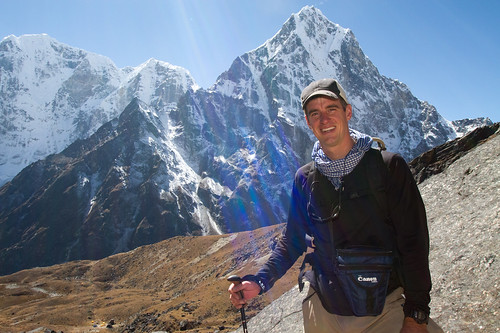One of the most important lessons taught at the Outside Adventure Film School is that every shot should tell a story. Film student, Gale Browning got the message. She also applied the same lesson to her still photos. One of the more outgoing of our soldiers is Chad Jukes, part mountain man, part goodwill ambassador. Chad sustained serious injury to his right leg after his truck hit an anti-tank mine in Northern Iraq, eventually leading to his losing his leg below the knee.
It was in the village of Namche Bazaar on the hike out that Chad encountered a small and very curious boy. Gale Browning was nearby taking photos and she snapped one of my favorite photos from the expedition.
Gale says "...the boy was looking at Chad with bewildered eyes, Chad stopped and removed his prosthetic leg much to the surprise of the boy". A wonderful photo.
Photo Courtesy of Gale Browning
By John von Seeburg
Tuesday, April 19, 2011
Monday, April 4, 2011
Inside the Outside Guy

A journalist on an expedition with a large group of mountaineers and soldiers faces a difficult task. Just fitting in with a crowd like that can be a challenge, all are tough nuts to crack for outsiders. Brian Mockenhaupt though had one thing in common with the subjects of his Outside Magazine story "The Other Side of the Mountain". He was a former infantryman and had served two tours in Iraq. When Brian walked the trails of the Khumbu and talked softly with the soldiers along the way, an important barrier was immediately broken. He could be trusted.
I recently spoke with the journalist who writes for the New York Times and Esquire, in addition to Outside Magazine:
How did the fact that you're a veteran impact your ability to do your job?
I often write stories about topics on which I don't have a knowledge base or
prior experience. That's one of the journalist's roles: step into unfamiliar
territory, make some sense of it, meet the people who inhabit that world, and
tell their story. But having served in the Army, including two combat tours in
Iraq, gave me a more immediate connection to the veterans on the climb, and a
deeper understanding of their experiences. I'd been through some of the same
emotions myself. The military is a tribe, and people within the same tribe often
have an easier time relating to each other. I've found the same thing while
embedding with military units in Iraq and Afghanistan since getting out of the
Army. But I was fortunate in that I didn't sustain the physical and
longer-lasting mental injuries that these veterans had. Being with them over
those three weeks, I was consistently inspired by their courage and
determination in overcoming limitations imposed by their injuries, and their
willingness to share very personal moments in their lives.
What was the highlight of the expedition for you?
The highlight for me was the time spent walking up the valley talking with the
guides and veterans, and hanging out with them at night. Of course, the climbing
was spectacular. Having never done an expedition like that, everything was new.
Walk around any bend, and you're confronted with another stunning view. And the
summit day, while challenging, was rewarding. But the trip was never about the
climb for me – except as seen through the eyes of the participants. So my main
interest was hearing about their lives, watching them take in the chaos of
Khatmandu and the beauty of the mountains and the challenge of the climb. As a
journalist, this was an ideal scenario. Nothing was rushed. The hours on the
trail and down time at the tea houses and at base camp gave me plenty of time
for casual conversation. If I wanted to explore something more deeply with a
veteran or a guide, I could walk with him on the trail the next day, or talk
about it over tea that night. And all of the guides and veterans were incredibly
open, willing to share their lives and talk about their experiences. That kind
of access is a luxury and a privilege.
By John von Seeburg
Subscribe to:
Posts (Atom)

